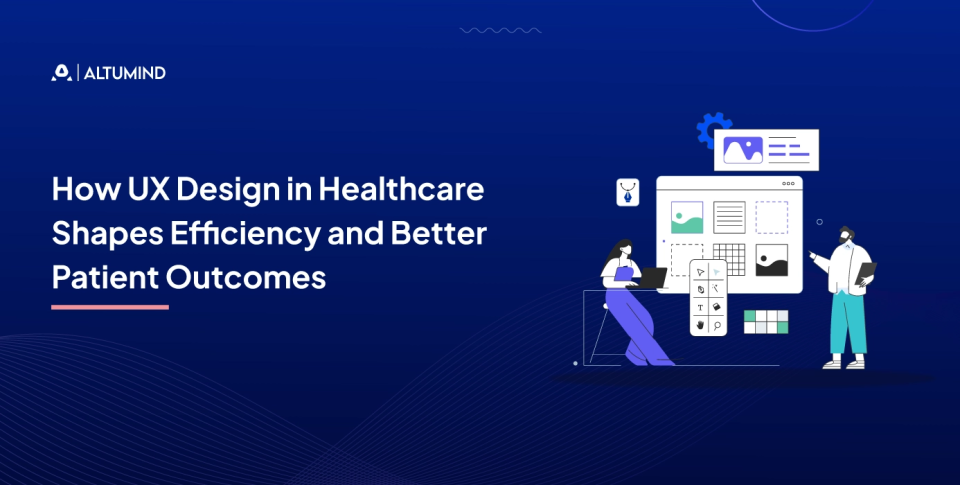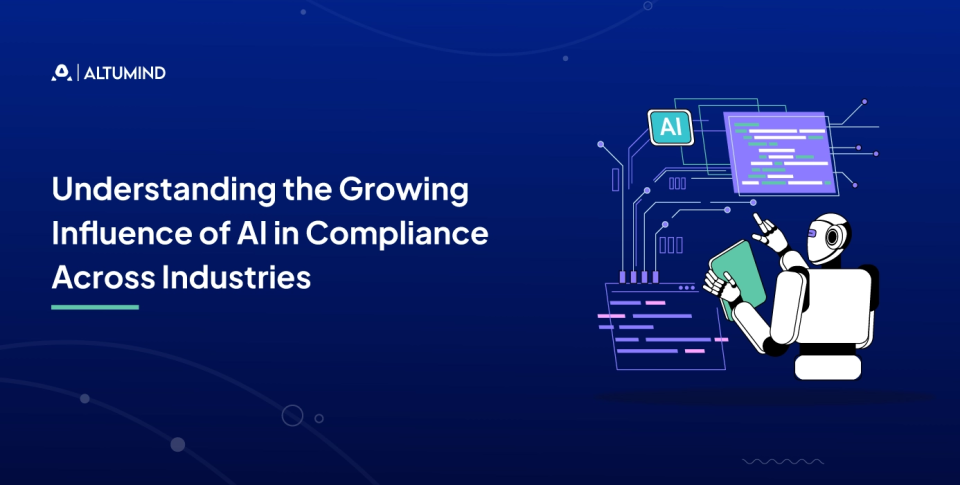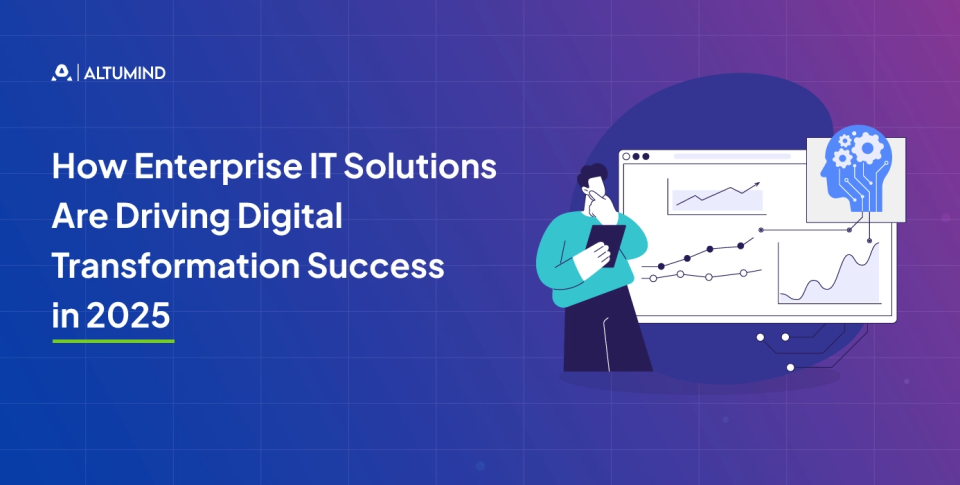Cloud Migration Case Study: Discover Real Enterprise Cloud Success Stories
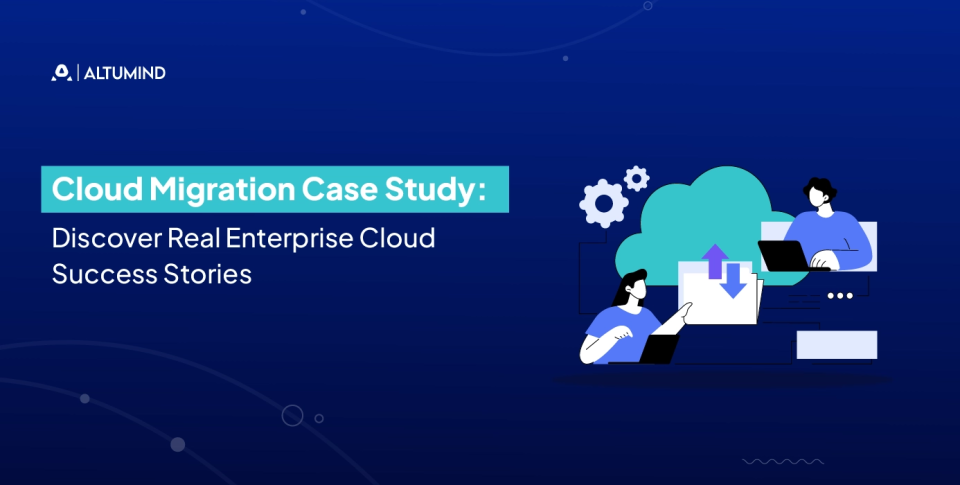
Most enterprises today deal with growing data volumes and complex operations that strain outdated systems. Legacy platforms demand constant maintenance, limit scalability, and make integration across departments slow and expensive. When systems cannot adapt, innovation stalls and decision-making becomes guesswork.
Every delay in accessing or analyzing data costs momentum. Manual processes cause teams to lose time, and silos bury critical insights. Security risks increase as disconnected applications create more exposure points. In a fast-moving market, businesses that rely on legacy infrastructure struggle to keep up with those already operating in agile, cloud-native environments.
Cloud migration eliminates these barriers by offering flexibility, resilience, and real-time intelligence. It replaces static systems with dynamic architectures that scale with business goals. With AI-driven insights and automated workflows, organizations gain clarity, speed, and confidence in every decision. In this blog, we will understand how cloud migration fuels sustainable growth and examine how Altumind transformed enterprise performance through a practical case study.
Understanding Cloud Migration
Cloud migration refers to the process of transferring data, applications, and digital operations from on-premise systems to cloud-based environments. It may also include shifting between cloud providers or integrating public and private setups in a hybrid model. The goal is to build a scalable and flexible infrastructure that supports faster innovation, stronger security, and improved cost efficiency.
Understanding the concept before reviewing a cloud migration case study is important because migration goes beyond technology replacement. It influences how efficiently teams collaborate, how securely data flows, and how effectively businesses respond to change. A clear grasp of these principles helps evaluate the outcomes of any migration strategy.
Market Insights
According to MarketsandMarkets, the global cloud migration services market was valued at USD 10.2 billion in 2024 and is projected to reach USD 29.2 billion by 2028, expanding at a CAGR of 23.3%. North America leads this acceleration due to rapid modernization, strong compliance adoption, and enterprise-wide demand for intelligent, scalable architectures.
Key Considerations in a Cloud Migration Strategy
A successful migration depends on structured planning, security alignment, and ongoing optimization. The following aspects often shape its effectiveness:
- Assessment of Current Systems: Identifying which workloads and applications bring the most value when moved to the cloud.
- Setting Clear Objectives: Aligning migration goals with broader business priorities such as agility, resilience, and data-driven growth.
- Selecting the Right Cloud Model: Choosing between public, private, or hybrid setups based on compliance, scalability, and performance needs.
- Security and Compliance Frameworks: Embedding data protection and governance protocols during every stage of migration.
- Continuous Optimization: Using analytics and automation to monitor usage, control costs, and maintain peak efficiency post-migration.
Cloud migration often lays the foundation for advanced capabilities like cloud-based analytics, where real-time data insights drive faster, more strategic decisions. Together, these technologies empower enterprises to modernize intelligently and scale sustainably.
Key Technologies and Latest Trends
Cloud migration is evolving with smarter tools and intelligent automation that drive speed, security, and scalability. A well-planned migration from on-premise to cloud ensures this evolution delivers measurable value through structured execution, reduced risk, and long-term operational efficiency.
- AI in Compliance and Security:AI in compliance is enhancing governance through automated audits, anomaly detection, and real-time monitoring. It helps enterprises maintain data integrity and meet evolving regulations efficiently.
- Hybrid and Multi-Cloud Models: Businesses are adopting flexible setups across AWS, Azure, and Google Cloud to balance performance, cost, and control.
- Serverless and Edge Computing: These technologies improve agility and processing speed by reducing infrastructure management and bringing computation closer to users.
- Automation and DevOps Tools: Solutions like Terraform, Jenkins, and Ansible streamline deployment, configuration, and performance monitoring.
- Sustainability-Focused Design: Energy-efficient architectures are becoming central to cloud strategies, aligning technology growth with ESG goals.
Phases of Cloud Migration
A successful cloud migration follows a structured, step-by-step process that minimizes risk and improves efficiency. The 7 steps of cloud migration act as a clear roadmap for smooth transition. The key phases include:
- Assessment: Analyze existing infrastructure, dependencies, and workloads to identify migration readiness.
- Planning: Define goals, timelines, and resource allocation while selecting suitable tools and platforms.
- Design and Architecture: Create a secure, scalable framework that supports future growth and compliance needs.
- Pilot Migration: Test migration with a small workload to validate performance, compatibility, and stability.
- Full Migration: Execute large-scale migration using automation tools to transfer data, applications, and systems.
- Optimization: Fine-tune performance, manage costs, and strengthen security using analytics and monitoring.
- Ongoing Management: Continuously monitor workloads, apply updates, and optimize resources for long-term success.
Cloud Migration Patterns
Enterprises adopt different cloud migration patterns based on their goals, system complexity, and long-term strategy. The most common approaches include:
- Rehost (Lift and Shift): Moving applications to the cloud with minimal changes for faster migration and reduced downtime.
- Replatform: Making selective optimizations, such as upgrading databases or frameworks, to improve performance without a full redesign.
- Refactor: Re-architecting applications to leverage cloud-native services like containers and microservices for better scalability.
- Repurchase: Replacing legacy systems with modern SaaS-based solutions to gain agility and reduce maintenance overhead.
- Retire: Eliminating redundant or outdated applications that no longer serve business needs.
- Retain: Keeping specific workloads on-premise due to compliance, security, or operational dependencies.
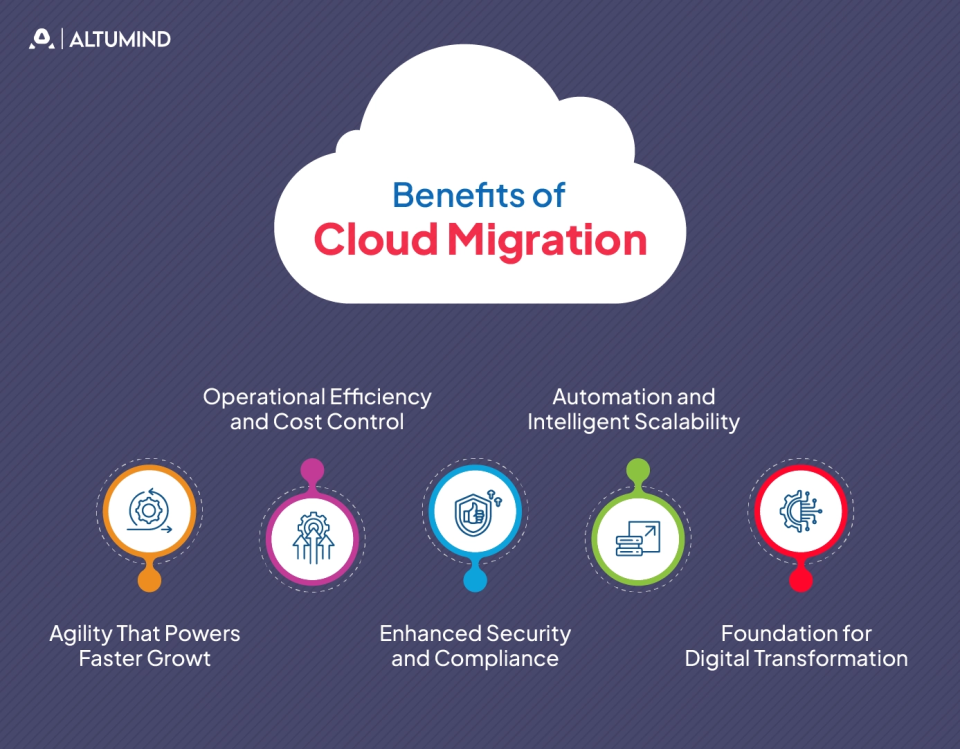
Benefits of Cloud Migration
Cloud adoption is transforming the way enterprises operate, innovate, and compete in the digital era. As reported by McKinsey, nearly 75% of organizations are migrating workloads to improve agility, automation, and scalability. When implemented strategically, migration strengthens both technology and business performance. The following benefits highlight how cloud transformation drives lasting value for modern enterprises.
1. Agility That Powers Faster Growth
Cloud environments allow businesses to deploy new applications and updates in a fraction of the time compared to traditional setups. Teams can respond quickly to market changes and customer needs without waiting for hardware upgrades or manual configurations. This flexibility enables enterprises to move from idea to implementation faster, reducing time-to-market and improving innovation velocity.
2. Operational Efficiency and Cost Control
Migration eliminates the overhead of maintaining physical infrastructure while introducing intelligent cost management tools. Through pay-as-you-go models and real-time resource optimization, businesses can scale efficiently. Studies show that 43% of migration projects are delivered on schedule and 20% even ahead of plan, proving that the right roadmap reduces both cost and risk while improving performance outcomes.
3. Enhanced Security and Compliance
Modern cloud platforms embed advanced security frameworks such as Zero Trust, encryption, and continuous monitoring. Enterprises benefit from built-in compliance with standards like GDPR, HIPAA, and SOC 2, reducing the burden of manual auditing. As systems come together in safe, organized spaces, the chances of security weaknesses decrease, providing better protection for important business data.
4. Automation and Intelligent Scalability
AI and automation within cloud ecosystems streamline repetitive processes such as provisioning, patching, and monitoring. This automation helps maintain consistent performance across global operations. With demand-based scalability, systems adjust automatically during peak usage, preventing downtime and ensuring seamless customer experiences.
5. Foundation for Digital Transformation
Cloud adoption forms the backbone of modern enterprise IT solutions in driving digital transformation. By integrating analytics, automation, and connected platforms, organizations can unify operations, improve decision-making, and deliver personalized experiences at scale. This synergy between technology and strategy positions enterprises to thrive in a competitive, data-driven economy.
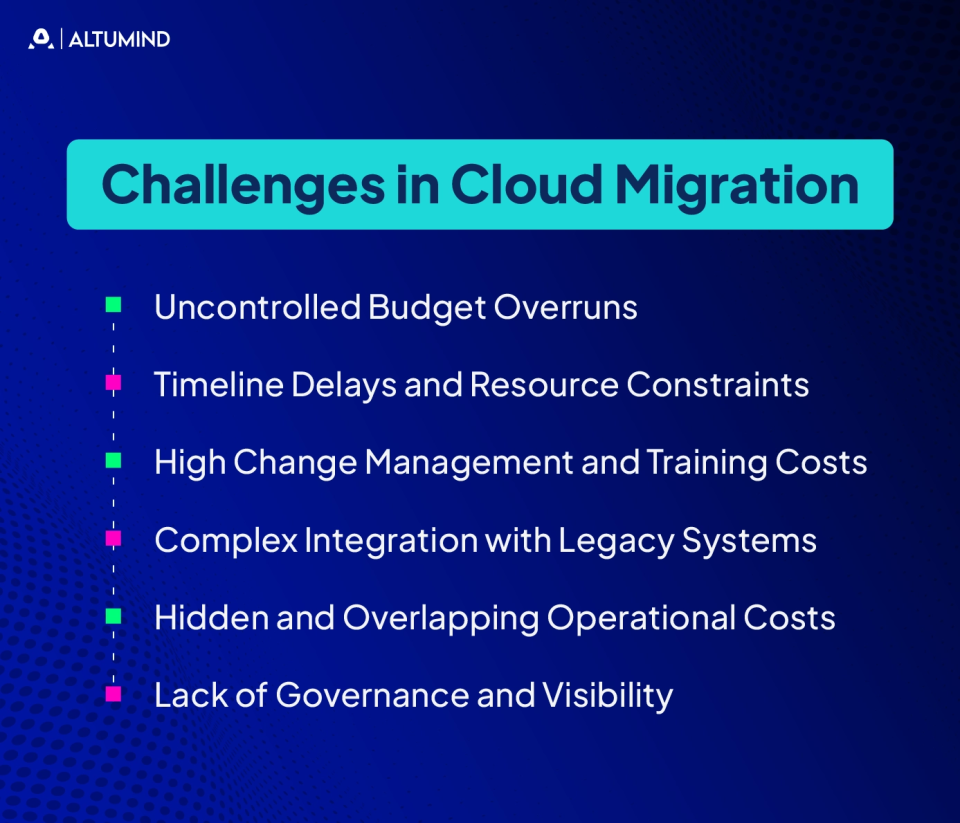
Challenges in Cloud Migration
Cloud migration offers measurable advantages, but without a well-defined roadmap, several pitfalls can hold you back from realizing the full benefits of managed services and long-term digital value. Despite widespread adoption, many enterprises struggle with cost control, integration complexity, and delayed returns. Research shows that 75% of companies exceed their migration budgets, while 38% of projects miss timelines, highlighting the importance of structured execution.
- Uncontrolled Budget Overruns
Cost overrun is one of the most common and damaging challenges in cloud migration. Studies reveal that 28% of companies exceed their initial budgets by more than 20%, often due to underestimated workloads, unplanned licensing fees, and data transfer costs. As migration progresses, new dependencies emerge, requiring additional infrastructure or consulting support. Without robust cost monitoring and governance, these expenses can escalate quickly, reducing the financial benefits expected from migration. - Timeline Delays and Resource Constraints
Even the most well-planned projects face schedule slips caused by technical and resource limitations. Around 13% of organizations report delays extending beyond three quarters, with teams often stretched thin across competing priorities. Testing, validation, and post-migration optimization require specialized skills that many enterprises lack internally. Extended timelines not only increase operational costs but also delay the realization of performance improvements, affecting business continuity and customer experience. - High Change Management and Training Costs
Nearly 45% of total migration spending is linked to managing change across the organization. Employees accustomed to legacy systems may struggle to adapt to new cloud-based tools and workflows. This transition demands training, communication, and leadership alignment to sustain productivity. Without clear change management practices, user adoption remains low, and the intended benefits of agility, collaboration, and automation remain underutilized. - Complex Integration with Legacy Systems
Integrating modern cloud platforms with legacy applications is both technically demanding and costly. Many legacy systems were not designed for distributed environments, which means significant re-engineering is required. Compatibility issues can interrupt data flow, create duplication, and raise security concerns during migration. The lack of standardized APIs and outdated coding structures can further slow down deployment, affecting mission-critical operations that rely on seamless data exchange. - Hidden and Overlapping Operational Costs
Cloud migration often leads to temporary “bubble costs,” where both old and new systems operate simultaneously to maintain business continuity. During this overlap, enterprises incur additional network and infrastructure charges that account for nearly 17% of overall cost overruns. These expenses are frequently overlooked during budgeting. Without close tracking and optimization, businesses continue paying for redundant systems long after migration, eroding ROI and increasing long-term technical debt. - Lack of Governance and Visibility
Governance plays a critical role in maintaining compliance, security, and financial control after migration. Yet, many organizations move to the cloud without a clear framework for performance tracking, access control, or cost reporting. This leads to underutilized resources, data silos, and inconsistent policy enforcement. A lack of visibility also hinders proactive decision-making, forcing teams into reactive problem-solving rather than continuous improvement.
The complexity of these challenges shows that successful cloud transformation demands continuous management, transparent governance, and expert oversight. Let’s now go further, as we demonstrate how at Altumind we addressed real-world challenges with the help of the relevant cloud migration case studies and insights.
Cloud Migration Case Study: Altumind’s Real-Transformative Impact
At Altumind, every transformation begins with a clear goal: to make technology work smarter for the business. Each cloud migration case study from our portfolio highlights how we help enterprises modernize legacy systems, strengthen scalability, and simplify operations through intelligent use of cloud infrastructure.
1. US-based Tools and Equipment Retailer: Vendor Collaboration Portal
Altumind developed a cloud-connected collaboration platform that automated the entire purchase order process for one of the leading tool and equipment retailers in the United States.
Using Oracle Cloud Infrastructure (OCI), we established periodic synchronization between on-premise systems and the cloud through a secure database link. This real-time sync enabled teams to access the latest data across multiple locations without manual updates.
The solution also introduced role-based access, automated workflows, and centralized dashboards that improved visibility and accuracy. As a result, the client achieved smoother operations, faster communication with vendors, and improved data integrity while significantly reducing manual dependency.
2. GRC Tech Leader: Platform Optimization on AWS and Acquia Cloud Next
For a global governance, risk, and compliance leader, Altumind re-engineered their existing platform to achieve higher performance and elasticity. By leveraging AWS and Acquia Cloud Next, our team modernized the application infrastructure to handle growing data volumes and complex integrations.
The focus was on building a scalable framework capable of supporting heavy analytics and real-time reporting. Through automation and optimized workloads, the platform now delivers faster response times, better availability, and reduced operational overhead, laying the foundation for future-ready growth.
3. Global Solar Tech Leader: Migration to Salesforce Marketing Cloud (SFMC)
Altumind helped the company transition its operations to Salesforce Marketing Cloud, migrating over 60 live campaigns with zero downtime. The challenge involved ensuring data consistency across multiple customer databases and maintaining campaign continuity during migration.
Our experts implemented a phased migration plan with automated testing and validation checkpoints. The result was a unified marketing ecosystem with real-time tracking, improved customer segmentation, and enhanced engagement efficiency.
4. Healthcare E-commerce Platform: Cloud-Ready Integration with Pimcore and QuickBooks
Altumind supported a healthcare platform in developing a cloud-ready architecture that integrated Pimcore for product information management with QuickBooks for finance automation. The solution replaced fragmented manual workflows with a centralized data hub hosted in the cloud.
This integration enabled real-time updates across sales, inventory, and finance systems, improving accuracy and transparency. The architecture was designed to be scalable, allowing the platform to expand seamlessly into new regions while maintaining consistent performance and compliance.
5. Germany-Based Real Estate Platform: Cloud-Hosted Digital Ecosystem
Altumind engineered a multilingual, cloud-hosted real estate platform designed to support property listings, payments, and customer interactions in real time. The system featured automated synchronization across multiple regions, integrated payment gateways, and data protection compliant with European privacy laws.
Hosting on a secure cloud environment allowed for faster transactions, reduced maintenance costs, and instant scalability. The platform now supports high traffic volumes while maintaining stability and superior user experience.
These real-world transformations show how strategic planning, advanced architecture, and secure automation can turn cloud migration into a long-term growth enabler for modern enterprises.
Conclusion
Cloud migration represents a decisive step toward building a smarter, more resilient digital enterprise. It empowers businesses to improve scalability, strengthen security, and simplify operations while paving the way for innovation. Through the combination of cloud app development services and continuous cloud migration support, organizations can achieve measurable performance gains and operational efficiency.
Each cloud migration case study discussed here reflects our commitment to helping enterprises transform with precision and confidence. Our solutions are designed to adapt to changing business needs, reduce complexity, and create long-term value. With the right strategy, technology, and guidance, cloud migration becomes a catalyst for continuous growth and digital excellence.
Let's Connect
Reach out and explore how we can co-create your digital future!





